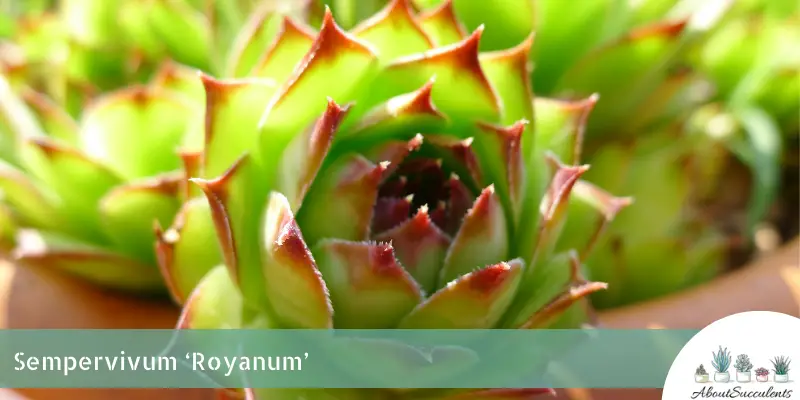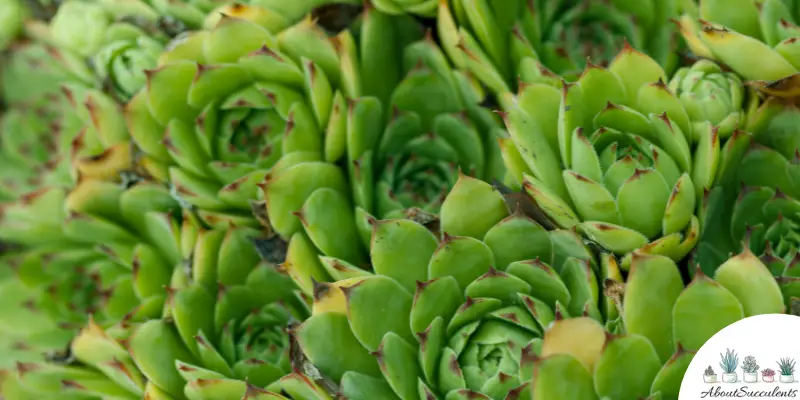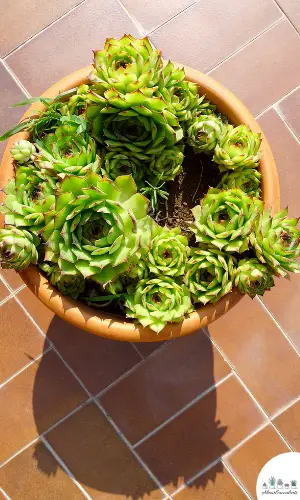
Sempervivum ( Royanum ) with its perfectly symmetrical rosettes is a succulent that beguiles its audience. The rosettes which can grow up to 15cm (5”) feature pointed leaves that are of yellow-green color with purple-tinted edges. A fully-grown Sempervivum can reach a maximum height of 20cm (8”).
If you want to grow Sempervivum Royanum, know that this is a monocarpic evergreen succulent plant. You might think your joy is short-lived because this succulent will die after blooming flowers.
Not to worry about as Sempervivum Royanum will gift you with offsets or pups that you can use to grow more of the plant.
Sempervivum also goes by the common names Houseleek and Hen and Chickens, the latter because of its ability to grow pups. In mid to late summer, Houseleek will produce star-shaped flowers that have a reddish-purple color.
Hen and Chickens is native to the Alps and is a member of the Crassulaceae family.
General Information
Also known as: Houseleek, Hen and Chickens
Plant Family: Crassulaceae
Origin: The Alps
Height: 20cm (8”)
Exposure: Whether outdoors or outdoors, expose Sempervivum ( Royanum ) to full to partial sun for up to 6 hours per day.
Water needs: Use the soak and dry method whereby the soil is given a thorough drenching and the next watering schedule is only when the soil has gone completely dry.
Soil type: Well-draining sandy soil with peat added to improve drainage.
Soil pH: 6.6 to 7.5.
How to Grow and Care for Sempervivum ( Royanum )

Sempervivum ( Royanum ) is the ideal succulent for beginners and people who are very busy because growing and caring for it doesn’t require much time and work.
Houseleek can tolerate frosty conditions as low as -29° C (-20° F). It will thrive in freezing regions as a garden or as a houseplant.
Sunlight
Sempervivum Royanum thrives in either full or partial sun. The important thing to remember is to expose the succulent plant to early morning or late afternoon sunlight. The rays of the midday sun can burn its leaves.
Whether you grow Hen and Chickens as an outdoor or indoor plant, it should get 4 to 6 hours of sun exposure. You can locate Houseleek in an area in the garden that offers full sunlight or partial shade.
Inside your home, the windows located in the south and west receive the most amount of sunlight. You can place Royanum near the south or west window. If lighting is a problem in your area, buy a Grow Light for Hen and Chickens.
Watering

When it comes to watering, less is best. If you give too much water, the roots of Sempervivum Royanum become susceptible to rotting.
How much is too much? If the soil is still moist, don’t give water. Always check the moisture level of the soil with your hand. Touch the topsoil and if it feels dry, you go and get the gooseneck kettle for watering.
A more effective approach is to insert a stick around 1 to 2 inches deep into the soil. If the stick feels dry at the inserted end, watering is good to go.
Don’t water from above and get the leaves wet. Always water the soil and never the plant. Watering the plant will keep it in a moist state longer.
Make sure the soil is thoroughly drenched because it might take some time between waterings.
Pot and Soil
Sempervivum Royanum is a durable and highly resilient type of succulent. Houseleek has been known to thrive even in poor quality soil as well as cracks and dried-out mountain walls.
That said, grow your succulent in good quality soil such as fresh, sandy soil which offers a well-aerated environment and fast drainage. You can never go wrong with improving drainage levels.
Add perlite, pumice, or coarse sand to help filter out excess moisture from the soil.
Fertilizer is not necessary but adding it to the soil will improve its nutrition level. Fertilize only once or twice a year but never during the growing season. Only use ¼ of the recommended amount of fertilizer. Always dilute the fertilizer with water.
How to Propagate Sempervivum ( Royanum )
As a monocarpic succulent, Sempervivum ( Royanum ), dies after it produces flowers. It usually takes 3 years for Houseleek to bloom. In that period, the succulent will produce offsets that you can use to propagate the species.
You can also try to propagate using seeds but the crucial component is the temperature. The best time to propagate with seeds is early spring when temperatures are warmer.
Method 1 – Offsets
Step 1: Gently pull out the offsets. You can also cut them off with a sterilized knife or garden scissors.
Step 2: Allow the offsets to develop calluses by letting them dry out for 1 to 2 days in a warm area.
Step 3: Plant the callused offsets in well-draining sandy soil.
Step 4: Water the soil only when it’s 100% dry.
Method 2 – Seeds
Step 1: Plant the seeds in a ceramic or terracotta pot filled with fresh, sandy soil. There’s no need to bury the seeds deep. You only have to press the seeds into the soil.
Step 2: Lightly moisten the soil by watering it with an atomizer.
Step 3: Cover the soil with plastic and locate it in an area that receives partial sunlight. Don’t position the pot where it receives direct sunlight. The ideal temperature for germination to occur is 21 ° C (70 ° F).
Step 4: Once the plant starts to grow, only water the soil when it’s completely dry.
Frequently Asked Questions
Is Sempervivum ( Royanum ) Toxic to Cats and Dogs?
Sempervivum Royanum is not included among the plants identified as toxic to cats and dogs. The list can be found on the website of the American Society for the Prevention of Cruelty to Animals (ASPCA).
Why is My Sempervivum ( Royanum ) Dying?
The leading cause of death for Houseleek is root rot due to overwatering. Another reason why your Hen and Chickens is dying is pest infestation because the succulent is drained of sap.
The key is to catch the symptoms in time and carry out ‘succulent first-aid’ to stop the spread of the fungal infection.
Overwatering
Succulents are special plants because they store water in their leaves and stems. They can survive without water for a long time. In fact, it’s better to neglect watering than to give water while the soil is still moist.
Root rotting occurs when the roots are kept in a moistened state for a long time. Usually, it takes the soil seven to 10 days to dry out. Faster during the summertime and longer during winter.
When the roots rot, a fungus can make its way inside the plant. You’ll know this to be the case if you notice discoloration or the sudden appearance of black spots on the leaves or stems.
Don’t waste time and retrieve a sterilized knife or garden shears. Cut off all the infected parts to stop the spread of the infection. After every cut, sterilize the tool with 70% isopropyl alcohol.
Discolored sections all removed, turn your attention to the roots. Remove the plant from the soil and cut off all the roots that have gone rotten.
Allow Houseleek to dry out while you prepare a new pot with fresh sandy soil. Replant Houseleek and apply the soak and dry method for watering.
Pest Infestation
Just because you don’t see them, doesn’t mean they’re not here.
Mealybugs, aphids, and other scale insects can be the cause of death of Hen and Chickens. These pests love the sap of the plant. If Houseleek is drained of sap, it will lose a big source of its nutrition.
But losing sap isn’t just the problem. All the biting on the leaves will leave wounds that will expose Hen and Chickens to a fungus making its way inside the plant.
Don’t wait for pests to live inside Sempervivum ( Royanum ). Spray it with neem oil or a mixture of 70% isopropyl alcohol that’s been diluted with water to keep the pests away.
If you notice cotton-like, powdery substances on the leaves, wipe them away with a cotton swab dipped in diluted 70% isopropyl alcohol. The substances are proof that mealybugs are inside your plant.
Yes, Sempervivum ( Royanum ) produces flowers in the mid to late summer months. The flowers are star-shaped, have a reddish-purple color, and grow on top of the stems.
Last Updated on June 9, 2022 by Sofia Lara